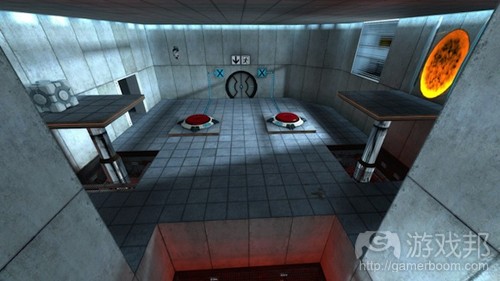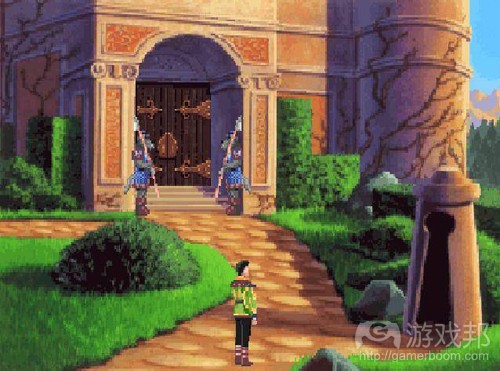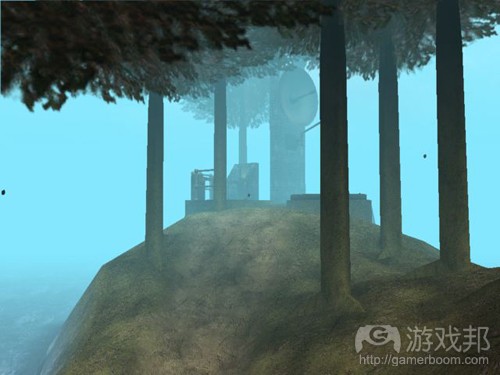从7个方面分析电子游戏中的挑战类型
作者:Chad Kilgore
什么是挑战?这个问题很难回答是因为我们能用于描述它的词语不外乎“生理的”或“心理的”。但这两个词并不能帮助我们从本质上理解游戏。根据“机制-动力-美学(MDA)框架”,“猜字游戏强调合作关系胜过挑战”;《雷神之锤》将挑战作为游戏玩法的主要元素”。我们固然认识到这两类游戏中的挑战是截然不同的,但却不知道怎么解释这种差异。我们必须跳出“生理的”或“心理的”模糊概念,从更确切的角度解释挑战。但怎么才叫更确切?
Raph Koster在“乐趣理论”中提出“ 乐趣就是学习的代名词。”乐趣来源于学习和掌握新的经验。我们对游戏潜在模式的学习程度达到纯粹和直觉的理解。就是这样。从根本上说,游戏就是学习的引擎。如果是这样的话,那么我们可以借用这个框架解释我们是如何学习的。
教育理论家Howard Gardner的“心智学习框架:多重智力理论”列举了7个不同的学习类型,即:
空间
语言
数学逻辑
身体动觉
音乐
人际
自我认识
在后来的研究中,他又引入另外两个:自然和存在。根据这个框架,当我们进入学习的情境时,这些智力类型是已经存在的,教育人员就是利用它们指导我们学习的。
与此类似,游戏也是利用这些智力类型引导玩家学习挑战。不可否认的是,Koster确实暗示了这些智力类型可以定义挑战。他认为:“这个列表意味着不同的人会对不同的游戏感兴趣,是因为他们的天赋不同……他们倾向于选择他们自认为有可能应对的问题和模式。”
这些问题和模式就是我们在游戏中遇到的挑战。本文将利用上述分类法解释挑战。
空间
空间挑战测试你理解、判断和在头脑中描绘空间的能力,这些与识别和利用空间模式有关。请注意,这些挑战与玩家移动或控制空间的能力是不同的。
拼图就是一种空间挑战类游戏,玩家要适当地组织这些奇形怪状的图块,使完整的图象显现出来。为此,玩家必须在头脑中模拟这些图块在“大图”中的样子。取决于玩家的能力和拼图的复杂度,在拼图过程中,玩家会将图块根据颜色和图样归类,然后把各类中相似的图块拼在一起。假如,你看到建筑的一个部分,你就会寻找更多有关的部分试图将建筑拼接完整;拼得越多,你就会越清楚这些图块在整个建筑中的位置,最终达到你的目标。
类似地,《传送门》这款游戏要求玩家知道在哪里使用传送枪以前就要理解所在的空间。例如,实验室05(见下图)的出口是一扇锁定的门,当同时按下两个按钮时,门就会打开。在一个平台上有一个方块,在另一个平台的方块则是传送门的末端。玩家必须明白如何移动空间,这样才能收集到方块,从而打开实验室的门。《传送门》中的每个房间都有这种设置,玩家要继续游戏就必须理解越来越复杂的空间。
语言
语言挑战测试你运用语言的能力,包括会话和书写能力、学习语言的能力、利用语言达到某个目标的能力。
比如填字游戏,玩家的目标是在空白的方格中填单字,组成词语或短语。为此,玩家必须确认和理解使用到的线索,将答案从类似的词语或短语中挑出来。试一下这个题:一种猫科动物。你必须回想属于“猫科动物”这一类的词语,并且词语的字数与方格数一致。要完成题目,你必须理解语言。
《猴岛的秘密》中的挑衅是另一个语言挑战的例子。玩家与一名海盗互相辱骂。一开始,海盗骂一句话,如“你会打架么,怎么力气小得像挤奶工啊!”你必须从你的语言库中找到适应的话回击他:
A “我希望你现在别挖鼻孔了。”
B “我给你一点小费,你懂得?”
C “你别颤抖得像鸡毛掸子。”
D “谁让你这么像奶牛呢?”
如果你在反驳中说了不合适的话,那么这一回合你就输了。连续战胜海盗(或海盗战胜你)三个回合后,你就赢了(或他赢了)。你的胜利取决于你理解反击台词的能力。
数学逻辑
数学逻辑挑战测试你对因果关系的理解力、运用数字、数量的能力和运算的能力。我们一般将这类挑战归类“心理的”挑战。
因果关系的常见例子是,你要用合适的钥匙打开一个锁,才能进入游戏的另一片区域。在《雷神之锤》的一个关卡中,有金色钥匙和银色钥匙,各能打开相同颜色的门。这是一个简单的因果关系。然而,锁和钥匙的对应不一定就这么直接。
在《国王秘使VI》中,当玩家第一次来到奇迹岛,会见到五个将入侵者扔进海里的地精。玩家必须一个一个地哄骗他们,依次使用发臭的花、机械夜莺、薄荷、兔脚和隐形墨水。换句话说,玩家必须使用钥匙(即道具)打开对应的锁(即地精)。
这类挑战的更复杂形式是,给玩家一堆通常关联不太明显的物品,必须将它们适当组合才能发挥钥匙的作用。记住,因果关系不一定明显得像钥匙与锁。任何具有可预测的事件的系统,在本质上都是以特定的活动为形成基础的。
其他数学逻辑挑战要求玩家具有数学能力,如会玩扑克牌的二十一点。思考一下:每一次,在牌组中抽掉一张牌,其他牌被抽出来的概论就增加了。如果你抽到红心女王,那么这张牌就不会再出现了,而剩下的牌被抽出的可能就升高了,因为此时牌的数量更少了。
为了最大化胜率,最小化败率,玩家要根据这些概率选择各种策略。在《龙与地下城》或《魔兽世界》中,当你最小化/最大化你的角色属性时,也是一样的道理。你要努力最小化不利或不重要的属性,最大化有利属性。最小化/最大化的经典使用案例就是,培养一个物理属性非常高的战士(如力量、敏捷),但同时牺牲精神属性(游戏邦注:如智力、智慧、领导力)。这两种策略都要求玩家具有数学能力。
经济、资源流通和管理上也存在类似的原理。在许多游戏中,玩家的挑战只是积累金钱。在《大富翁》中,玩家要买卖道具、参加拍卖活动和收租。但游戏的经济并不限于金钱。任何可以创造、移动、储存或损坏的资源(无论是物质上还是概念上)都与经济有关。
Andrew Rollings和Ernest Adams认为:“甚至在FPS中也有简单的经济现象:玩家得到弹药的方法是捡到或从死亡的对手身上拿走;消耗弹药的方法则是用武器射击。”与此类似,游戏中还有健康值、魔法值、背包容量、不动产和节约能力。挑战的程度越高,资源供应量比需求量的值就越小。无论资源是什么,游戏都要求玩家评估其价值。
身体动觉
身体动觉挑战测试玩家控制自己的身体运动的能力、操作物品的能力以及时间感和反应力。你可以把身体动觉理解成“行动的挑战”。
一般来说,粗糙动觉挑战测试的是玩家调动大肌肉组来执行诸如跑、跳或保持平衡等任务。例如,猜字游戏就具有广义动觉挑战。在游戏中,一名玩家利用身体姿势帮助同伴猜到自己正在想的电影、书籍、名人等。如果你想的是“Harry Potter”,那么你可以做出挥舞魔法杖的动作,或者用手势暗示同伴你的前额有块伤痕。你还可以假装在制作陶器(在英语中,“Potter”的意思就是“制陶工人”)。无论你做的动作是什么,你要利用身体传达信息而不是说出或写出信息。
在《劲舞革命》中也有类似的挑战。在游戏中,箭头会向上移动并越过一排静止的箭头。当移动的箭头与静止箭头重叠时,你要用脚点跳舞毯上的相应箭头。游戏就是这样让玩家像跳舞一样动起来,要求玩家具有粗糙身体控制能力。
精细动觉挑战测试玩家调动小肌肉组执行更精确的动作的能力。例如,积木层层叠就是一种考验玩家身体敏捷度的游戏。在游戏中,玩家要把积木从塔中抽出,然后把积木放到塔的顶部。移掉几块积木后,玩家要分析各个手指应该出多少力,然后调整。类似地,玩《光晕》时,为了通过空间,玩家必须让拇指使出最合适的力气按模拟杆,然后将拇指移动去按其他按钮。这些都要求玩家进行力度上的细微调整。
身体动觉挑战的范围还进一步拓展到时间感和反应力。时间感就是根据游戏中发生的其他事,在正确的时刻执行动作。在《波斯王子》中,玩家在最后一秒按下跳跃按钮,使角色跳过深坑,这就是一个时间感的例子。而反应力指的是快速响应的能力。比如,在《热手游戏》中,在手放下前快速移动双手;或者,立即响应快速事件的提示。
音乐
音乐挑战测试玩家识别和回想音乐音高、音调和节奏的能力。
以《Loom》为例,它的玩法以音乐为中心,因此所有互动活动都以四个音符为一组序列的形式出现,称之为曲调。当游戏时,玩家通过观察与曲调有关的物品学习。例如,通过观察“把刀磨得锐利”学习“尖锐”曲调。此时,玩家的拉线杆,也就是编织咒语的工具会发光,提示玩家正确的音符。然而,如果玩家玩的是“专家”,那么拉线杆就不会提示玩家了,玩家必须靠自己的耳朵听。这就要求玩家具有很强的乐感。
同样地,在《神秘岛》的Selenitic年代中,奔腾直下的瀑布、唔咽的风、和炽热的峡谷,玩家要识别出这些声音。最显著也可能最令人迷惑就是地下洞穴的大迷宫,它是与Mazerunner相连的。
当玩家第一次游戏时,看起来很简单:一个前进按钮,一个后退按钮,一个左转按钮,一个右转按钮和一个罗盘。按下前进按钮,一只小钟就会响起“乒”的声音。经过几次尝试和错误后(或回想机械时代的音调),玩家会发现,原来声音对应的是罗盘的指向。
事实上,各个方向都有相应的声音:“乒”声指北,“唧”声指西,“嘭”声指东,“咚”声指南。知道这种对应关系后,玩家可以根据各个交叉点上的线索轻易地穿过洞穴。尽管这个任务让你走得晕头转向,但你识别乐声的能力可以让你省去看地图的麻烦。
人际
人际挑战测试玩家理解他人的意图、动机和期望的能力,与察颜观色和根据理想目标调整方案有关。尽管外向的和好交际的性格可能有帮助,但并不是要求。
以扑克牌为例。最成功的玩家不是掌握计算概率的人,而是能够观察对手、根据对手的细微动作推测他们的牌的人。当对手第一次看他们的手时,如果你认真观察,他们的兴奋或失望是逃不过你的眼睛的。或者,如果他们的行为突然改变(如一个爱说话的人突然变沉默了),你就知道怎么回事了。一旦你琢磨到对手的潜在心理,你就知道怎么玩这场游戏了。
与此类似,《L.A. Noire》中的审问也是考验玩家察颜观色的能力。玩家通过威胁嫌疑人,判断对方是否说谎。一些显著的信号如大汗淋漓、眼珠转动和坐立不安都说明嫌疑人没有说实话。虽然任何误会都可能导致嫌疑人提供错误的信息或拒绝提供信息,但如果你能正确解读这些行为,就能更加接近真相。
请注意,人际挑战要求玩家的沉浸感达到社交的水平。如果你把与你交往的人当作机器上的齿轮,那么你就把他们理解成因果关系中的元素了。另外,这些挑战不同于与他人游戏时感觉到的乐趣。挑战要求克服障碍,因此,这种挑战的障碍就是人。
自我认识
自我认识挑战测试玩家的自我意识能力,也就是,理解自己的心情、态度、恐惧、经历、倾向和动机等的能力。事实上,你本人就是挑战。
成功运用自我认识挑战的一个实验游戏是《Brainball》。在游戏中,你和对手要竞争桌上的球的移动控制权。为此,你们两人各自戴上包含电极的头带。当你们表现镇静和放松时,电极会读取你们的脑波来使球向前移动。所以为了取胜,你的心情必须放松,精神要集中。相反地,如果你总是感到压力,那你就会输。
一定程度上,《生化危机》和《寂静岭》也利用了自我认识挑战。这些游戏可以让你心跳加速、嘴巴干燥、手心冒汗。想象一下,在《寂静岭2》中,当你第一次碰到那个三角头的怪物。当你目睹它在角落里杀害两名模特儿时,你一定会惊慌失措:这是什么东西?你是不是被困住了?你是有不大难临头了?从本质上来说,你面临的挑战是,克服自己的恐惧,认清当前形势。
自然
自然挑战测试你识别和分类自然和非自然物品的能力。
以《Peekaboom》为例。这款游戏要求玩家随机扮演不同的角色:Peek和Boom。Peek首先看到的是黑色屏幕,而Boom的是与一张与之相关的图片(见下图)。
Boom要做的就是慢慢地揭露图片的部分,让Peek猜出相关的词。例如,如果图片上显示的是一头奶牛和草地,与这张图片相关的词是“奶牛”,那么Boom只揭露包含奶牛的图象部分。为了获胜,Boom和Peek都必须理解特定物品包含的特点。
然而,自然挑战并不总是关于识别自然物品。例如,在《Shivers II》中,在一张纸纹图上有一串数字5559547。那是什么?保险箱号码?密码?这串数字是毫无意义的。你可能会眼睁睁地盯着这串数字而不知所措——我就是这样。
但是,如果这串数字是写成555-9547,那就马上清楚了:这是一个电话号码。如果没有那个连字符,它们只是随机排列的数字而已。现在你可能已经将这些数字当成一个电话号码了,就算没有连字符。但问问你自己,如果将数字写成“五百万五十五万九千五百四十七”,你还会这么快反应过来吗?
不要把这类挑战与钥匙和锁的因果关系混为一谈。当你拣起《国王秘使VI》中的机械夜莺时,你除了知道它会唱歌,你可能不理解它与空间能有什么关系。理解物品和它的交互作用对空间的影响,和理解物品到底是什么,显然是完全不同的挑战。
存在
存在挑战测试你思考关于生命与死亡的“大问题”的能力。这类挑战要求你从道德的层面上,决定应该怎么做;这是处理对与错的关系,与社会风俗、宗教信仰或法律无关。最近,游戏中的道德问题已经成为游戏业中倍受关注的一大问题。
这类挑战通常出现在游戏中,既有明显善良也有明显邪恶的形式——可能还有中性的,大体上是走极端的。例如,在动作冒险游戏《耻辱》中,玩家被迫选择拯救女友Trish的生命或几名医生的生命。换句话说,这个问题就是“一条命比几条命更重要吗?”因为游戏的结构,你立即就知道什么选择是道德的,什么选择是邪恶的。
然则,这些挑战也可能不太黑白分明;两种不同的举动可能看起来一样道德或一样邪恶,这取决于你如何看待它们。例如,偷窃是错的,但如果是因为不想被饿死而偷食物,你还觉得这是邪恶的吗?
这种选择的含糊性令人三思。《创世纪V》中也有这种没有明确选择的挑战。在它的一个迷宫中有一个监狱,关在牢房里的是孩子。
当你走进这个监狱,你可以看到这些孩子们,你会想救他们。但因为游戏的规则,在地牢中的任何“友好的”角色其实都是怪物。也就是,当孩子们被放出来,就会立即进攻救他们的人。游戏的设计师Richard Garriott回忆道:
“我认为,这是一个有意义的小问题,难道不是吗?因为我太清楚游戏并不关心你是杀他们还是不理他们。这都不重要,但我知道这会在你心里形成一个心理图景——让玩家产生任何矛盾心理都是有利的。因为这样才会迫使人们思考它。”
你释放他们了吗?如果是,你会为了自保杀掉他们吗?无论你选择怎么做,游戏不会惩罚你,也不会奖励你。这不是一个微不足道的问题。
总结
现在我们总结一下所有挑战:
1、空间:将空间作为挑战
2、语言:将语言作为挑战
3、数学逻辑:将数字作为挑战
4、身体动觉:将身体控制作为挑战
5、音乐:将声音作为挑战
6、人际:将人作为挑战
7、自我认识:将自己作为挑战
8、自然:将自然作为挑战
9、存在:将“大问题”作为挑战
值得一提的是,有许多挑战原型并没有出现在本文中(游戏邦注:如迷宫、谜语、小题大作、物理益智等)。无论如何,仍然可以在这个分类法中理解它们。另外,一种挑战并不一定限制于一个分类中;可能包含多种智力类型。例如,在《波斯王子》中跳过深坑有要求玩家具有良好的运动技能,还要有空间感知和判断能力。
但这到底意味着什么?借助这些词,我们可以更深刻地理解如何运用这些挑战创造玩家的体验。
猜字:身体动觉(粗糙)、人际
《龙与地下城》:数学逻辑、人际
《猴岛的秘密》:数学逻辑、人际
《神秘岛》:数学逻辑
《雷神之锤》:身体动觉(精细)、空间
《传送门》:空间、数学逻辑
《耻辱》:身体动觉(精细)、空间、人际、存在
以上,我们可以看出这些游戏各自使用了什么挑战。当我们将猜字游戏与《雷神之锤》作比较时,我们会发现前者更强调粗糙的身体动觉,而不是人际挑战,而后者更注重精细的身体动觉,而不是空间挑战。利用各种公式模型,我们可以理解挑战如何影响玩家的体验,更好地分析玩家的体验,从而指导我们的游戏设计、研究和批评。(本文为游戏邦/gamerboom.com编译,拒绝任何不保留版权的转载,如需转载请联系:游戏邦)
Understanding Challenge
by Chad Kilgore
What is challenge? Talking about challenge is difficult when the vocabulary we have is limited to “physical” or “mental.” It doesn’t give us the necessary tools to examine games with any sort of substance. The Mechanics-Dynamics-Aesthetics (MDA) framework states “Charades emphasizes Fellowship over Challenge; Quake provides Challenge as a main element of gameplay.”1 We inherently recognize that the challenges between these games are significantly different, but there is no language available to explain that difference. We need to move away from vague, ambiguous words like “physical” or “mental” and toward a more definitive vocabulary. But what?
In A Theory of Fun, Raph Koster wrote “fun is just another word for learning.”2 Fun comes from learning and mastering new experiences. We learn a game’s underlying patterns to the point of absolute and intuitive understanding. It’s simply what we do. Fundamentally, games are engines for learning. And if this is the case, then we could borrow a framework that explains how we learn.
Educational theorist Howard Gardner’s study Frames of Mind: The Theory of Multiple Intelligences outlines seven different learning styles, comprising:3
Spatial
Linguistic
Mathematical-logical
Bodily-kinesthetic
Musical
Interpersonal
Intrapersonal
In his later work, he introduced two more: Naturalistic and Existential.4 In this framework, all of us enter a learning setting with these intelligences already in place and the educator draws upon and addresses these intelligences to guide learning.
Likewise, games draw upon these intelligences to guide learning in the form of challenges. Admittedly, Koster does briefly hint that these intelligences could provide a vocabulary. He states: “the list suggests right off the bat that different people will be interested in different sorts of games because of their natural talents… they’ll select problems and patterns they think they have a chance at solving.”
These problems and patterns are the challenges that we see in games. This article intends to examine challenges with regards to the aforementioned taxonomy.
Spatial
Spatial challenges test your ability to understand and judge space, and represent that space within your mind. They involve the recognition and use of patterns in space. Do note that these challenges are separate from the player’s ability to move through or manipulate the space.
A jigsaw puzzle is a spatial challenge that involves properly arranging numerous oddly-shaped pieces to reveal a complete picture. To do so, you need to internalize the pieces and see them in the “big picture.” Depending on your ability and the complexity of the puzzle, this is typically done incrementally, arranging the pieces into groups according to colors and patterns, and assembling mini-puzzles from each group. If you notice a part of a building, you find and add more pieces to construct that building’s features. You continue to add more and more pieces, understanding how each fits in the whole, until you accomplish your goal.
Similarly, Portal is a game that requires you to internalize a space before knowing where to use the portal gun. For instance, Test Chamber 05 (see below) consists of a single door to with a lock that opens when two buttons are simultaneously depressed. There is one cube down in a pit and the other is on top of one of two platforms. On the other platform is an end of a portal. You must understand how to move through the space so that you can collect the cubes and open the door. This setup extends to each room in Portal, requiring that you understand more and more complex spaces in order to continue.
Linguistic
Linguistic challenges test your capacity to use language. They involve spoken and written language, the ability to learn languages, and the capacity to use language to accomplish certain goals.
Consider a crossword puzzle. The goal is to fill all of the empty squares with letters and form words or phrases. To be successful, you need to identify and understand the clues being used, differentiating between any similar words or phrases. Take the following puzzle: feline: C _ _. You need to recall a list of words with a similar meaning as “feline” that are three letters long and start with the letter “C”, all of which require you to understand language.
Insult sword fighting in the Secret of Monkey Island is another example of a linguistic challenge. It involves you and a pirate flinging insults and counter-insults at one another. To start, the pirate presents an insult, such as “You fight like a dairy farmer.” You must retort with the appropriate counter-insult from your collection to win the round:
A “I hope now you’ve learned to stop picking your nose.”
B “And I’ve got a little TIP for you. Get the POINT?”
C “First you better stop waving it like a feather-duster.”
D “How appropriate. You fight like a cow.”
A nonsensical response causes you to lose the round. After you win (or the pirate wins) three consecutive rounds, you win (or he wins) the fight. Your ability to understand your potential retorts determines your success.
Mathematical-Logical
Mathematical-logical challenges test your understanding of the underlying principles of causal systems, or to manipulate numbers, quantities, and operations. Typically, these are the challenges that we refer to as “mental” challenges.
A common example of a causal system is a lock (actual or metaphorical) that prevents you from accessing an area of the game and all you have to do is to bring it the appropriate key. Quake uses gold and silver keys, each of which opens respective colored doors within a level. It’s a simple cause-and-effect system. However, locks and keys do not need to be so literal.
In King’s Quest VI, when you first travel to the Isle of Wonder, you meet five sense gnomes that throw invaders into the sea. You need to trick each of them, one by one, with a flower of stench, a mechanical nightingale, a mint, a rabbit’s foot, and invisible ink. In other words, you need to use the appropriate key (i.e. the items) on the appropriate lock (i.e. the gnomes).
More complex forms of these challenges present a set of objects, often related in ways that are not directly obvious, that need to be manipulated to make a key. Keep in mind that causal systems are not limited to locks and keys. Any system that has predictable events based on specific actions is causal in nature.
Other mathematical-logical challenges require mathematical skill, such as those used in blackjack. Think about it: Each time a card is drawn from the deck, the probabilities of drawing other cards increases. If you draw the Queen of Hearts, then that card is guaranteed to not come up again, and the remaining cards have a higher probability of being drawn, since the deck is now smaller.
Various strategies based on these probabilities have been derived in order to maximize the chances of winning and minimize the chances of losing. The same principle is applied when you min/max your character in Dungeons & Dragons or World of Warcraft. You are trying to minimize undesirable or unimportant traits and maximize the desired ones. The classic application of min/maxing is to make a fighter with very high physical traits (i.e. strength constitution, dexterity) at the expense of mental traits (i.e. intelligence, wisdom, charisma). Both strategies are applications of number manipulation.
Similar principles extend to economics, the flow and management of resources. In many games, the challenge is simply to accumulate money. In Monopoly, you buy and sell properties, participate in auctions, and collect rent with this goal in mind. But economies in games are not limited to money. Any resource that can be created, moved, stored, or destroyed either physically or conceptually can be considered.
Andrew Rollings and Ernest Adams said, “Even a first-person shooter has simple economy: Ammunition is obtained by finding it or taking it from dead opponents, and it is consumed by firing your weapon.”8 Likewise, there are health, mana, inventory capacity, real estate, and the ability to save. The degree of the challenge is proportional to the supply of the resource against its demand. Regardless of what the resource is, the game challenges you understand its value.
Bodily-Kinesthetic
Bodily-kinesthetic challenges test your ability to control of your bodily motions, capacity to handle objects skillfully, and sense of timing and reaction. One way to understand bodily-kinesthetic challenge is to view it as the “challenge of doing.”
At the large scale, gross-kinesthetic challenges test your use of large muscle groups to perform tasks like running, jumping, or balancing. For example, charades uses gross-kinesthetic challenges. You use gestures and your acting abilities in order to make your team guess the movie, book, celebrity, or whatever it is that you are thinking of. If you were thinking of “Harry Potter,” you could wave an imaginary wand around or maybe gesture a scar on your forehead. You could play with your hair and then mime forming clay (i.e. being a potter). Regardless of what you gesture, the idea is for you to use your body to communicate instead of verbal or written language.
A similar type of challenge is experienced in Dance Dance Revolution (DDR). During play, arrows scroll upward and pass over a set of stationary arrows. When the scrolling arrows overlap the stationary ones, you tap colored arrows with your feet on the dance platform. The game moves you around in such a way to approximate dancing, demanding gross physical control.
Looking at the smaller scale, fine-kinesthetic challenges test your ability to use smaller muscle groups to perform tasks that are precise in nature. For example, Jenga is a game of manual dexterity that involves removing blocks from a tower and moving those blocks to the top of the tower. Over the course of several small moments, you are required to analyze and adjust the amount of force each individual finger is using. In the same way, when playing Halo, you have to apply the ideal amount of pressure on the analog sticks with your thumbs to move through the space, move your thumb off of the analog stick to press other buttons, and perform numerous minor adjustments.
Bodily-kinesthetic challenges further include the concepts of timing and reaction. Timing is about acting exactly at the right moment, coordinating with something else happening in the game. Running and jumping across a chasm by pressing the jump button at the last second in Prince of Persia is an example of timing. On the other hand, reaction is about acting as fast as possible. Quickly moving your hands before they are slapped in a game of Hot Hands or instantly responding to a prompt from a Quick Time Event are examples of reaction.
Musical
Musical challenges test your ability to recognize and recall musical pitches, tones, and rhythms.
Consider Loom. Its gameplay centers on music so much so that all interactions come in the form of four-note sequences called drafts. As you play the game, you learn drafts by observing objects that have qualities of a relevant draft. For example, you learn the “sharpening” draft by watching a blade while it is being sharpened. Normally when this happens, your distaff — a tool used for spell weaving — glows with the appropriate note. However, if you play as an “expert” then your distaff is not marked and you must play solely by ear, demanding an even stronger understanding of pitch and tone.
In the same manner, the Selenitic Age in Myst with its trickling waterfalls, whistling winds, fiery chasms, and the sound of wind whistling through crystalline formations requires you to recognize audial patterns. Most notable and probably misunderstood, is the vast maze in the underground caverns of the Age, which is traversed with what is known as the Mazerunner.
When you first sit down in its pilot chair, it looks simple enough: a FORWARD button, a BACKTRACK button, a LEFT button, a RIGHT button, and a compass. By pressing FORWARD, the runner is lowered onto a track and a small bell sounds – ping. After some trial-and-error (or by recalling the tones from the Mechanical Age), you can learn that sound is a cue corresponding to a compass heading.
In fact, each direction has an associated sound: “ping” means north; “chirp” means west; “spring” means east; “dong” means south. Knowing this, you can easily travel the caverns by following the cues at each intersection. Although this task does have you traversing a maze, your ability to recognize the musical patterns circumvents any need to map the space.
Interpersonal
Interpersonal challenges test your ability to understand the intentions, motivations, and desires of other people. They involve reading people and changing your approach to achieve a desired goal. While being extroverted or liking other people may be beneficial, it is certainly not a requirement.
Take poker, for example. The most successful players aren’t masters at calculating probabilities. Instead, they are able to read their opponents, noticing the slightest nonverbal gestures and inferring their feelings about their hands. If you closely look at your opponents when they first look at their hands, most won’t be able to hide their excitement or disappointment. Or if there are sudden changes in their behavior for a hand (e.g. somebody who is normally very talkative suddenly becomes quiet), you know something is going on. Once you get a good read on someone you’ll know when to cut your losses or play aggressively.
In the same way, interrogation in L.A. Noire tests your ability to read people. By asking something compromising, you determine whether the suspect is telling you the truth or lying. Some notable tells are sweating, shifting eyes, and nervous tics. Being able to correctly read the suspect’s behavior leads you closer to the truth, while any misunderstandings cause the suspect to either provide bad or no information.
Do note that interpersonal challenges require engaging people at a social level. If you’re interacting with others as though they’re cogs in a machine, then you understand them as elements in a causal system. Additionally, these challenges are different from the pleasure felt when playing with or against other people. Challenges require overcoming obstacles; in this case, the obstacles are people.
Intrapersonal
Intrapersonal challenges test your level of self-awareness. They deal with your capacity to understand your feelings, opinions, fears, experiences, preferences and motivations. In effect, you are the challenge.
One game that masterfully uses intrapersonal challenge is the experimental game Brainball. In the game, you and your opponent compete to control a ball’s movement across a table. To do so, the two of you each wear a strap containing electrodes around your foreheads. The electrodes read alpha and theta waves generated when you are calm and relaxed, which move the ball forward. So in order to win, you need to be relaxed and focused. Conversely, if you are stressed, you will lose.
To a lesser extent, the same can be said about games like Resident Evil and Silent Hill. These games can make your heart race, mouth dry, and palms sweat. Consider the first time you stumble across the pale, overtly muscular figure with a large red, triangular head in Silent Hill 2. The ghastly scene is completely unexpected as you witness it rape and murder two mannequins from a nearby closet. What the hell is this thing? Are you trapped? Are you safe? At its core, you are challenged to overcome your fear and understand the situation at hand.
Naturalistic
Naturalistic challenges test your ability to recognize and categorize both natural and unnatural artifacts.
Let’s take the game Peekaboom [pdf link] by way of example. The game involves two random players taking different roles in the game: Peek and Boom. Peek starts out with a black screen; Boom starts with an image and a word related to it (see the screen below.)
Your goal, as Boom, is to slowly reveal portions of the image so that Peek can guess the related word. For example, if the image contains a cow and a field, and the word associated to the image is “cow,” then you reveal only the parts of the image that contain the cow. Both you and Peek need to understand what characteristics constitute any particular artifact in order to succeed.
Contrary to its namesake, naturalistic challenges do not always involve identifying natural artifacts. For instance, in Shivers II, a series of numbers is revealed after holding a finger-printed piece of paper to a flame: 5559547. What is it? A safe combination? A password? The number is meaningless. You may stare blankly at this number not knowing what to do – I did.
Yet if it were written as 555-9547, it’s immediately clear that it’s a phone number. Until that leap, the number is just random noise. Now you may have recognized the number as a phone number even without the hyphen. But ask yourself, would you have recognized so quickly if it were written as “five million five hundred fifty-nine thousand five hundred forty-seven”?
These challenges should not be confused with lock-and-key causal systems. When you pick up the mechanical nightingale in King’s Quest VI, you may not understand how it interacts with the space — other than it sings — but you know that it is a mechanical nightingale. Understanding how an artifact and its interactions affect the space and understanding what the artifact actually is are distinctly different challenges.
Existential
Existential challenges test your ability to ponder the “big questions” about life and death. They ask you to question how you ought to act, morally speaking. They deal with right or wrong, not with social conventions, religious beliefs, or law. Recently, these challenges have become a more established category throughout games, ranging from board games to video games.
Such challenges are often expressed in games as either obviously good or obviously evil – maybe neutral, often substantially rewarding the extremes. For example, at one point in the action-adventure game Infamous, you are forced to choose between saving the life of your girlfriend Trish and saving the lives of several doctors. In other words, it asks the question “Is one life more valuable than the lives of many?” And due to the game’s structure, you immediately know what choice is good and what choice is evil.
However, these challenges may not be clear-cut; two different courses of action may seem equally good or equally evil, depending on how each one is viewed. For example, it is wrong to steal. But is it wrong to steal food if the only alternative is to starve?
This ambiguity of choice forces one to take pause. Ultima V presents such a challenge where there is no clear choice. Deep in one of its mazes is a room filled with jail cells. Inside those cells are children.
When you enter the room, you can see the children and want to save them. But due to the limitations of the game, any “friendly” characters in a dungeon behave as monsters. This results in the children attacking their would-be rescuer as soon as they’re set free. Richard Garriott, the game’s designer, recalls:
“Well, I thought, that is an interesting little problem, isn’t it? Because I knew darn well that the game doesn’t care whether you kill them or whether you walk away. It didn’t matter, but I knew it would bring up a psychological image in your mind, an image that was in my mind — and any conflict you bring up in anybody’s mind is beneficial. It means a person has to think about it.13
Do you set them free? If so, do you kill them to save yourself? There are no benefits or penalties for either action. It is not a trivial problem.
Summary of Challenges
Now we can assert that all challenges from across the history and into the future of games can be understood using the following:
Keep in mind that there are numerous archetypal challenges that were not specifically cited (e.g. mazes, riddles, Rube Goldberg machines, physics puzzles). Regardless, they can still be understood in this taxonomy. Also note that a challenge is not necessarily limited to a single category; it may involve multiple intelligences. For example, while running and jumping across a chasm in Prince of Persia does involve fine-motor skills, it also involves understanding and judgment of space.
But what does this really mean? The vocabulary provides a more informed understanding of what and how challenges are used to create the player experience:
Charades: Bodily-kinesthetic (gross), Interpersonal
Dungeons & Dragons: Mathematical-logical, Interpersonal
Secret of Monkey Island: Mathematical-logical, Interpersonal
Myst: Mathematical-logical
Quake: Bodily-kinesthetic (fine), Spatial
Portal: Spatial, Mathematical-logical, Bodily-kinesthetic (fine)
Infamous: Bodily-kinesthetic (fine), Spatial, Interpersonal, Existential
Here we can see how each game uses challenge similarly and differently. When we compare charades and Quake, we can see charades emphasizes gross-kinesthetic challenge over interpersonal challenge while Quake emphasizes fine-kinesthetic challenge over spatial challenge. As with any formal model, by understanding how challenges impact the player experience, we are better able to break down that experience and use it to guide design, research and criticism.(source:gamasutra)











































 闽公网安备35020302001549号
闽公网安备35020302001549号